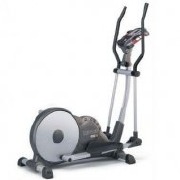
When you are establishing your workout program, one of the factors you must take into consideration is whether to include high and low impact exercise in your routine. Some people even choose to create a program that is a combination of both high and low impact exercise.
Identifying the difference between high and low impact exercise is simple. If you are moving and one foot stays on the ground the whole time, you are doing low impact exercises. If both feet are off the ground, you are doing high impact exercises.
For example, if you practice step aerobics, no matter how high you stack the steps, one foot is on the ground or the step the entire time. This makes it a low impact exercise. However, you can use your step for both high and low impact exercise. If you jump over or run in a circle around the step, this makes it a high impact exercise. Your health care professional or personal trainer can help you choose between high and low impact exercise.
What Is Meant By High Impact Exercise?

To better understand the difference between high and low impact exercise, you need to take a closer look at both. An exercise or activity in which both of your feet come up off the ground at the same time is a high impact exercise.
Both high and low impact exercise is beneficial to your health. However, high impact exercise has a positive effect on bone health. In addition, high impact exercise also improves agility, endurance, coordination and balance.
High impact exercise is essentially the activities that most people enjoyed as a child, such as jumping rope. You will have fun mastering the skills that once gave you such great pleasure as a child.
The intensity, coordination and effort that it takes to perform high impact exercise may seem difficult initially, but once you learn the skills and your fitness levels increase, you will be glad you made the effort, and start enjoying the benefits of both high and low impact exercise.
The intensity and jarring of high impact exercise may not be the ideal fitness routine for everyone. If you have joint problems, an autoimmune disorder, a cardiac condition or any other medical issues, consult your health care professional to decide whether a high or low impact exercise routine is right for you.
What Is Meant By Low Impact Exercise?

Before creating your fitness plan with high and low impact exercise, consider the unique benefits of each. Low impact exercise is usually light, gentle and easy exercise that can be done by people who do not want to practice a high impact exercise routine.
Both high and low impact exercise is beneficial to weight loss. In fact, a low impact exercise program can help to lose weight by burning calories just as well as a high impact exercise routine.
For a number of people, high impact exercise is simply not an option.
Some Reasons You May Choose Low Impact Exercise Instead:
- Extreme obesity
- Beginning fitness participant
- Chronic issues such as stress fractures, osteoporosis or arthritis
- Bone, joint or connective tissue injuries
- Pregnancy
With low impact exercises, one foot or the other is always in contact with the ground. You may have to work a little harder to get your heart rate to its target zone, but low impact exercise is a great way to get in shape for many people.
A List of High and Low Impact Exercise
The effectiveness of high and low impact exercise varies from person to person. If you are just starting out with a fitness routine, you may be more comfortable with low impact exercise until your body adjusts to regular exercise.
Once you are able to perform the low impact exercises with ease, you can gradually add a few high impact exercises to add to the intensity of your workout. Alternating between high and low impact exercise is a great way to ensure that your entire body gets a workout.
High Impact Exercises Include:
- Jumping rope or skipping
- Plyometrics
- Leaping
- Running
- Jumping jacks
- Step aerobics if you jump off and over the step.
Low Impact Exercises Include:
- Step aerobics without jumping
- Low impact aerobics
- Swimming
- Roller blading
- Treadmill
- Walking
- Hiking
When thinking about high and low impact exercise, you will realize that there are definite benefits to both high and low impact exercise, depending on the effort that you dedicate to it. Remember to talk with your physician before beginning any fitness routine. He or she should be more than happy to help you decide between high and low impact exercise, or both.




Be the first to comment